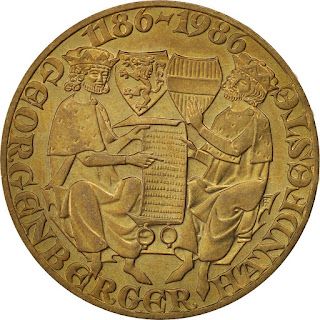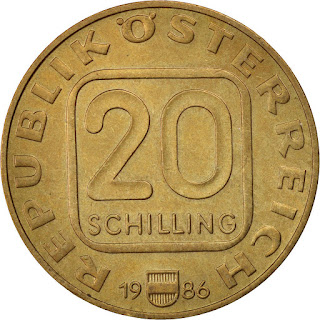Austrian Coins 20 Schilling 1986 800th anniversary of the Georgenberg Pact
Commemorative issue: Steiermark - 800 Years of Georgenberger Handfeste
Obverse: Two figures of Duke of Styria Otokar IV and Duke of Austria Leopold V holding the text of the treaty; between their heads two shields with Coats of Arms of Styria and Austria; along the top edge: 1186-1986; along the bottom edge: GEORGENBERGER HANDFESTE (Georgenberg Treaty).
Lettering: 1186 - 1986 TP GEORGENBERGER HANDFESTE.
Designer: Kurt Bodlak, Thomas Pesendorfer (concave initials TP on a textile behind Duke of Austria on the reverse)
Engraver: Kurt Bodlak.
Reverse: in the coin centre inside a square with rounded corners in two lines face value: 20 / SCHILLING; below year of issue divided by a shield in colours of Austrian flag; along the top edge: REPUBLIK ÖSTERREICH (Republic of Austria).
Lettering: REPUBLIK ÖSTERREICH 20 SCHILLING 1986.
Engraver: Josef Kaiser.
Years: 1986-1993.
Metal: Aluminium-nickel-bronze.
Weight: 8 g.
Diameter: 27.8 mm.
Thickness: 1.8 mm.
Shape: Round.
Mint: Münze Österreich (Austrian Mint), Vienna.
Mintage:
1986 801 000
1991 100 000
1992 100 000
1993 180 000
Georgenberg Pact
The Georgenberg Pact (German: Georgenberger Handfeste) was signed on 17 August 1186 on the Georgenberg mountain above Enns. Also called the Georgenberg Compact, it has been called by English-speaking historians a "Styrian Magna Carta", for it sought to guarantee the rights of the Styrian ministeriales in anticipation of the Babenberg acquisition. It consisted of two parts. The first part was an agreement between Duke Ottokar IV of Styria (from the Otakars dynasty) and Duke Leopold V of Austria (from the Babenberg dynasty). The childless and deathly ill Ottokar, who had contracted leprosy while on the Third Crusade, was to give his duchy to Leopold and to his son Frederick under the stipulation that Austria and Styria would henceforth remain undivided. The second part consists of a delineation of rights of the Styrian estates.
The territory of Styria at the time went far beyond the modern Styrian state and included lands not only in modern Slovenia, but also in Upper Austria, more precisely the Traungau (the area around Wels and Steyr).
The case of succession came to pass in 1192. With the exception of an interlude between 1194 and 1196, Styria has since then remained connected to Austria. The Georgenberg Pact thus was the first step towards the creation of the complex of lands of Austria, which was continued under the Habsburgs during the Late Middle Ages. The Pact was confirmed in 1237 by the Holy Roman Emperor Frederick II.

